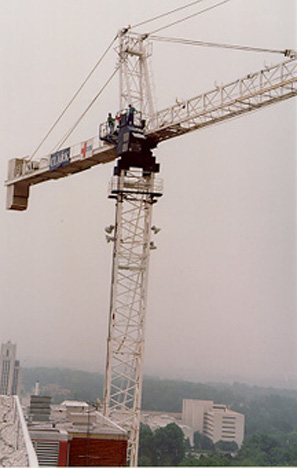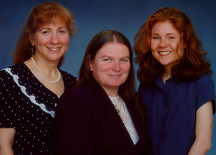|
|
 |
George Simmons (left)
operates one of the tower cranes that's been looming over the Clinical Center
for the past few months. NIH staff physician Dr. Alan Zametkin (right) wanted
to know more. See the story. (Photo by Bill
Branson)
|
Board recommends CC budget, hears reports on strategic
plan
The Clinical Center's Board of Governors unanimously voted
to recommend approval of the CC's $224 million budget for FY98 during their
meeting here July 10. It goes next to Dr. Harold Varmus, NIH director, for
his consideration.
Personnel costs consume most of the proposed budget pie.
"Total
personnel costs for '98 are $136.7 million or 61 percent of the budget when
both contract and government FTE costs are included," Dr. John Gallin,
CC director, pointed out.
"The contract service element, which is 17 percent of
the total budget, is the next major expenditure and it's made up of all
the maintenance contracts for sustaining equipment, repairs, utilities,
plant maintenance, and off-campus rental facilities."
The budget also sets aside $32.1 million for supplies and
$5.8 million for independent CC research. Another $7.7 million is earmarked
for new equipment, including:
--$100,000 for development of a new molecular diagnostics
lab in the Clinical Pathology Department, which is in collaboration with
NCI and NHGRI.
--$125,000 for an echocardiogram for Critical Care
Medicine.
--$2.55 million for a new 1.5 Tesla magnetic resonance scanner
for the Diagnostic Radiology Department. --And, $1.6 million for Information
Systems Department hardware, software and licenses, and telemedicine
development.
The FY98 budget reflects essentially the same level of funding
as provided in the current budget, a continuing commitment by Dr. Gallin
to maintain the quality of services within limited ICD budgets.
About $2.7 million was added to the original $221 million
in FY97 with the transfer of two labs to the Clinical Center. They are the
Laboratory of Diagnostic Radiologic Research, previously a part of the NIH
Office of Intramural Research, and the Multi-Modality Radiologic Imaging
Process Systems from NCRR.
In his update to board members, Dr. Gallin outlined four new
projects being developed under the umbrella of the CC's strategic plan.
"I challenged the department heads during our March retreat
to come up with ways to identify cost savings in our budget by being creative.
The outcome of the retreat was to modify our strategic plan to include four
new projects-contract assimilation; management tools; incentives development;
and procurement savings."
Major elements for each include:
Contract Assimilation--conversion of selected large
contracts to in-house operations to save money without compromising the
quality of care and support offered to the institutes. Contract assimilations
under consideration are surgical services and anesthesiology; respiratory
care and physiological monitoring; PET technicians; and secretarial and
clerical support for the Diagnostic Radiology Department. This initiative
could generate up to $2 million in savings, Dr. Gallin told the group.
Executive information systems--a series of related
initiatives aimed at providing institute and CC managers information and
tools to maximize productivity. A contract is in the works to analyze what
internal management systems exist and how they can be enhanced, Dr. Gallin
noted.
Linchpin of this project is a cost-accounting system.
"We've
never had a cost-accounting system here and we want to develop a good one,
or at least evaluate the virtues and cost of having a good one," Dr.
Gallin said. "We want to be able to accurately project the cost of
all new protocols as they're developed and then use that process to help
ICDs track the costs as time goes on."
Incentives development--a system to reward employees
for their cost-savings and productivity. "We need a system for rewarding
employees who do a good job in this regard."
Procurement--purchasing goods at the lowest costs
through consolidation of maintenance contracts, equipment standardization,
use of the DOD Prime Vendor program, and expanded use of purchase cards.
index
|
Projects serve up an
era of change for building
10
|
The face of the
Clinical Center is about to
change forever.
First up is construction of the south entry, which will serve as the
CC's main front door for the duration of the project. That begins this
month.
"Actual construction of the new entry and drive should be completed
by April 1998," noted Yong-Duk Chyun, CRC project director for NIH.
"Between April and August of next year associated mechanical work will
be completed."
Construction of the new building to the north will begin in October.
Initial site preparations include demolition of building 20, relocation
of utilities, and realignment of Center Drive. That work will continue until
next June, when actual excavations will get under way.
All these construction phases will have specific consequences for campus
parking, officials note. (See story on parking, page six.)
Watch for signs specifying what construction involves and how it will
affect parking and building access. Other communications efforts are planned.
"We want to make sure that everyone is kept informed about the project
and how it will affect day-to-day operations," Chyun explained.
index |
Lagana named CC's first chief
financial officer

|
Michele T. Lagana has
been named chief financial officer
for the Clinical Center.
"This is a new position for the Clinical Center," said Dr.
John Gallin, CC director, in announcing the appointment. "Lagana will
help us develop a cost-accounting system for the hospital, which will allow
us to more closely monitor our budget and track costs. It's central to our
efforts in giving CC and institute managers the information and tools they
need to enhance productivity and, most importantly, to preserve the quality
of research."
"This is an exciting time to be joining the CC team," Lagana
said, "with the building of the new CRC, development of more informative
financial systems for management decision-making, and establishment of the
new governance structure."
Since 1988, Lagana had been assistant vice president and controller at
Providence Hospital in Washington, D.C., a 408-bed hospital and 240-bed
nursing home.
Prior to that position, Lagana was with the Medlantic Health Care Management
Corporation, also in Washington, serving as assistant director of financial
analysis from 1976-1987 and assistant director for financial planning from
1984-1986.
Lagana holds a B.A. in finance and economics from Towson State University
and earned the M.B.A. from George Washington University. She is a member
of the Healthcare Financial Management Association and the Maryland Health
Care Coalition.
index |

| A ladder zig-zags up the 270-foot tower crane that George
Simmons operates. |
|

Simmons's base of operations is a cozy blue cab that puts
a chorus of controls
at his fingertips.
|
|

| George Simmons's view from the top offers a panorama
of the NIH campus.
He's a tower crane operator and spends work days towering over the Clinical
Center. (Photos by Bill Branson) |
|
Dr. Alan Zametkin, NIH
staff physician, watched an
astounding variety of materials float up and down past his fourth floor
office window. Steel beams. Buckets of concrete. Carts full of trash and
debris. "Given that these exceedingly heavy objects have passed within
two to three feet of my window, I wondered who was in fact hauling this
vast array of materials so close to my enclave in the Clinical Center,"
he explained. "Many people at NIH-including me-have marveled at the
precision and skill that these crane operators have. I wanted to know
more."
He had an opportunity to find out more about the man behind the machine
just after sunrise one summer morning and shares the story with
CCNews. |
Crane operator's office is a room with
a view
For many, it takes years to climb the ladder to the top of NIH. George
Simmons does it in about five minutes a day, five days a week.
Simmons is a tower crane operator for Clark Construction Company. The
crane he operates towers over the Clinical Center's east wing. It's one
of two 270-footers put into place late last year as part of the NIH Essential
Maintenance and Safety Program. The Clinical Center's wings are having their
roofs raised to allow installation of new air-handling and safety systems.
A tower crane operator for 17 years, Simmons moves hundreds of tons of
massive and unwieldy building materials between narrow canyons of building
walls to the top of the Clinical Center.
Simmons's touch at the crane's control panels hasn't always been as deft
and true as it is today. "I began operating heavy machine equipment
after graduating from high school," he said. "My father operated
cranes and heavy equipment, too." During a lunch break one day, the
young worker accepted an invitation to climb a crane tower for the first
time. He recalls clinging to the ladder with such intensity that his hands
literally ached-the classic white-knuckle syndrome. He was absolutely
petrified.
But he persisted and gradually, after several more climbs, the fears
and anxieties were put to rest. An apprenticeship set him on his way as
a professional tower crane operator. In those early days, Simmons worked
slowly and hadn't developed his precise skills in placing the crane's hook.
Co-workers pouring concrete in 100-degree heat were not inclined to silently
and patiently wait for Simmons to hone those skills.
"One guy told me in no uncertain terms that I should go home and
never come back," Simmons recalled. And he almost followed that advice.
"For the first month, I hated the job and swore I wouldn't continue."
But he did continue, mastering the delicate controls of the tower.
Work atop the Clinical Center, he says, is actually much slower paced
than the usual construction job because the work doesn't involve constructing
a building from the ground up. "At other jobs, we may go two or three
weeks working straight through the days without even a lunch break,"
he said. During peak periods of construction activity, the tower crane
operator's
skills and talents are in demand as many as twelve hours a day.
Tower cranes, which rent for about $10,000 a month, have dramatically
changed the construction industry over the years, Simmons pointed out, because
they allow rapid placement of huge amounts of building materials. They appeared
on the construction scene in the mid-1960s.
Extremely bad weather usually means a temporary construction halt for
most projects, but it takes more than a stiff breeze and a little thunder
to bring Simmons down from his perch. The crane is grounded and can take
winds of up to 45 miles an hour.
The crane's long arm--jib-- isn't locked into place at night and freely
moves in the wind acting like a tremendous weather vane. When Simmons is
on board the crane, it, by design, can sway as much as five feet at the
top. The crane's will flex up to 10 feet, depending on the load being carried.
Sometimes Simmons has to walk out to the end of that arm for inspections
and maintenance.
Because safety is at the top of every crane operator's agenda, close
calls are rare. Simmons remembers one while he was on another job. His shirt
accidentally caught on one of his crane's control levers, sending the crane's
trolley out over the building they were working on. It snagged a construction
worker, who scrambled to attach his safety harness to the crane's hook.
When he realized what was happening, Simmons quickly lowered the snagged
worker to safety.
Then there are the lighter moments. Like the time Simmons was working
on a job in Washington, D.C., hoisting materials off a 13-story building
guided only by radio directions from co-workers on the roof.
One item was a toilet that needed to go curbside for cleaning. "The
signal man on the roof said, by radio, that the cleaning was finished and
to take it back to the roof." But the cleaning wasn't finished and
the man doing it was still inside. He made it about 11 floors up before
his screaming tipped off the crew and he was sped safely back to ground
level.
From a distance, we've admired the skills and coordination of these men
behind the machines. Up close, their professionalism is impressive. And
we appreciate the efforts of the entire construction team that allow us
all to continue our work here into the next century. (by Dr. Alan Zametkin)
index |

|
Construction takes
toll on parking; options outlined
Looking for a place to park? So have NIH planners.
Beginning this month, campus construction will have an increasing effect
on parking-or the lack of it-and campus officials are plotting a multi-level
course of action to deal with it. Work associated with the new south entry
for the Clinical Center and relocation of Center Drive in preparation for
CRC construction will have major impact.
"This isn't 'new' news," points out Stella Serras-Fiotes, master
planner in the Division of Engineering Services, facilities planning and
programming branch, a part of the NIH Office of Research Services. "We
have been working on the parking plan with these losses in mind."
Recently opened temporary lots have already provided some relief. They
are located south of lot 41B; in front of the Cloister; near Natcher; by
the electrical power station at building 17 (near the Metro); and at NLM
. "With the completion of temporary parking lots, we've actually added
100 more spaces than the 300 parking spots that were lost when parking lot
13C closed earlier this summer," Serras-Fiotes said.
Here's what's ahead for August:
--All campus visitor parking will be consolidated Aug. 4 in four
pay-for-parking
facilities with attendants-the temporary lot at Natcher, the top
two-and-a-half
levels of MLP-8, part of lot 4A (between buildings 1 and 31), and the P3
level of the parking garage. In P3, there is no parking charge for patients,
visitors to patients, and other authorized users. Other current visitor
parking will be reassigned to employees (MLP-6, lot 41B and C, lot 31E).
--Parking meters-135 of them-will be installed near building 13, 36,
38, and Natcher.
--Attendant-assisted parking will be instituted for employees who park
on the lower levels of MLP-8.
--Construction personnel will no longer be able to park in lot 41B.
They will have to park off campus, which frees up another 150 spaces for
employees.
In September expect:
Parts of lot 10H, south of the CC's library entrance, will be closed
in three phases as work begins on the Clinical Center's new south entry.
"The lot will have to be reconfigured to allow for the modified traffic
circulation patterns associated with the new entry," explained
Serras-Fiotes.
Between Sept. 2 and Oct. 13, work will be along the entire west side
of the parking lot. The second phase, expected to continue until Nov. 24,
will involve the north side of the lot. The final phase, covering the east
and southeast edges, should be complete just after the first of the year.
During the first and third phase, about 75 spaces will be lost; up to 140
during the second phase.
When work to relocate Center Drive begins in September, lots 20A and
B-170 spaces-will close.
On tap for October:
Lot 20C will close. Strike another 100 parking spots.
Lot 10C, which is between buildings 10 and 49, will lose about 50 spaces
in mid-October as the NIH utility tunnel project continues. ·Lots
31A-H are slated to become attendant-assisted parking areas, which will
increase capacity for employees by about 330 spaces.
"Since the CC is particularly hard hit by the loss of campus parking,
we're considering an option to provide attendant-assisted parking for employees
at levels P1 and P2 of the garage, which could increase the capacity by
at least 200 spaces," Serras-Fiotes said. That plan would have to wait
until completion of repairs to the P1 ramp, expected to begin in mid-August
and continue through the end of October.
index |
Long-time CC
employee dies
Co-workers, family, and friends of the late Jesse J. Ferguson crowded
into Masur Auditorium on July 8 for a service in his memory.
Ferguson died days before his planned retirement from federal service.
A native of Nacogdoches, Texas, he began his federal career at the Clinical
Center in 1961. He began with the local-transportation section, working
through the ranks serving as chief of the patient escort service, chief
of the admissions section and as clinic administrator, and deputy chief
of the Outpatient Department.
Although he lived in the Washington area for nearly 40 years, Ferguson,
the memorial program noted, remained a Texan at heart and was a devoted
Dallas Cowboys fan. |
 "He dedicated himself to the patients and mission
of the Clinical Center and his zeal to ensure compassionate, efficient patient
care guided his every action. He could be found at work days, nights, weekends,
and holidays, sometimes in his white lab coat, others in his baseball cap
and bib overalls." "He dedicated himself to the patients and mission
of the Clinical Center and his zeal to ensure compassionate, efficient patient
care guided his every action. He could be found at work days, nights, weekends,
and holidays, sometimes in his white lab coat, others in his baseball cap
and bib overalls."
He also found time to volunteer with D.C. youth programs and he coached
youth and men's football teams.
Those wishing to make contributions to a memorial fund may contact Nancy
Schulze or Gracie Millender in the Outpatient Department. The phone number
is 496-2341. The memorial fund will benefit youth programs at the Lamond
Riggs Community Center.
index |
 |
Dietitic interns
Graduation ceremonies were held July 25 for the latest group to finish
the NIH Dietetic Internship. They are (from left) Susan Holster Hodge, a
graduate of Hunter College; Jan Madden, a Hood College graduate; and Marion
Vetter, a graduate of Cornell. index |
From the director
by Dr. John I. Gallin, CC director |
At NIH, Boards of Scientific Counselors
review our science. They assess
research that's proposed and in progress. They evaluate the productivity
and performance of staff investigators. The purpose is to make sure that
research at NIH is efficient and of the highest possible quality.
Similarly, we at the Clinical Center need a formal mechanism to take
a long, hard look at our operations and how we function as an organization
in order to be efficient and productive while preserving the quality of
science and research. That is why I have proposed a new departmental review
process to the CC Board of Governors that will help CC departments evaluate
and improve their individual operations.
My goal is to have a very frank and constructive review process of the
operational aspects of each department to find out what is working well
within the Clinical Center and what needs fixing.
I've proposed a rotating schedule of reviews that would ensure a
top-to-bottom
survey of departmental performance once every three years.
The survey team will include internal and external experts experienced
in the individual areas they will survey. Users of departmental services
may be included on the team and certainly will be able to provide input.
A member of the Board of Governors will head the group.
The Clinical Center's new chief financial officer, Michele Lagana
is leading a team of CC and NIH staff to refine our structure of review,
define how to use the information we discover, and develop and evaluate
subsequent efforts to improve department performance.
Evaluation results will be presented to the Board of Governors. One of
the board's charges is to evaluate the performance of the Clinical Center.
How well departments work in serving NIH's patient-care, research, and
administrative
needs is a critical element of that performance.
The Clinical Center has never had a process in place to conduct this
systematic review of department operations. I believe this will be a
constructive
and valuable process for us all.
index |
Feedback
|
Last month's reminder of the Clinical
Center's smoking policy prompted
the following comments from readers:
From a staff member: On numerous occasions I have noticed people
smoking in front of the Clinical Center and the police officer on duty doing
nothing about it. Are you serious about enforcing the smoking policy? Signs
have been installed but some people--sometimes patients--can't read or choose
to ignore the no-smoking signs. I, for one, would appreciate stricter
enforcement.
Let's practice what we preach.
From a staff member: I've been working in the NIH library for
the last five years. I think the July 1995 restriction on smoking around
the CC has done very little to curb the horrible smell of smoke creeping
into the hallway outside the library, and consequently the library itself.
The main reason, I believe, is the lack of any security enforcing the law.
Smokers, especially patients and non-staff persons, constantly light up
right outside the entrance and sometimes even inside. The main issue, get
some security presence in the back of building 10, start seriously enforcing
the smoking restrictions outside the library, push the smokers outside from
under the canopy and the overhang outside the cafeteria. Make this truly
the National Institutes of Health.
From a patient: I've been a patient here for nine years and
appreciate
all the good work that goes on here. I sometimes think that the smoking-related
littering is in part a protest on the part of the smokers. We haven't been
provided with ash receptacles so that we can properly dispose of the smoking
litter and there's no comfortable, protected seating provided to encourage
smokers to move away from the building.
The CC director responds:
Asking for NIH police assistance in enforcing our smoking policy is an
avenue that I will pursue with NIH and police officials. Signs indicating
where smoking is not permitted are in place and we'll add more as needed.
Ash receptacles are located along the perimeter of the building. If more
are needed in different places, fax the suggested locations to 402-2984.
Unfortunately for smokers, however, the Clinical Center will not provide
amenities such as shelter and seating for staff and visitors who choose
to smoke.
Our policy is clear--don't smoke within 100 feet of any entrance or posted
no-smoking area. Smoking is not allowed in the parking garage or in stairwells.
When smokers do not comply with this policy, smoke is drawn into the building
creating unhealthy and unpleasant conditions for everyone.
Out of consideration for our patients and staff, we ask that smokers
respect these rules and that they not litter our grounds with smoking-related
trash.
index |
top | cc
home page | nih home page
|
| Clinical Center
News, Building 10, Room 1C255, National Institutes of Health, Bethesda,
Maryland 20892. (301) 496-2563. Fax: 402-2984. Published monthly for CC
employees by the Office of Clinical Center Communications, Colleen Henrichsen,
chief. News, articles ideas, calendar events, letters, and photographs are
welcome. Deadline for submission is the second Monday of each month. Editor:
Sara Byars, webmaster@cc.nih.gov. Staff Writer: Sue
Kendall. |
|

